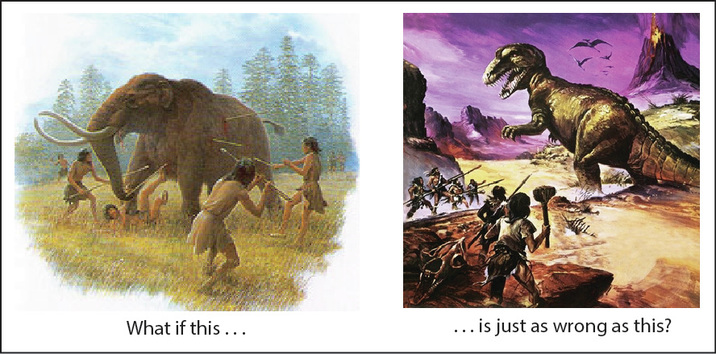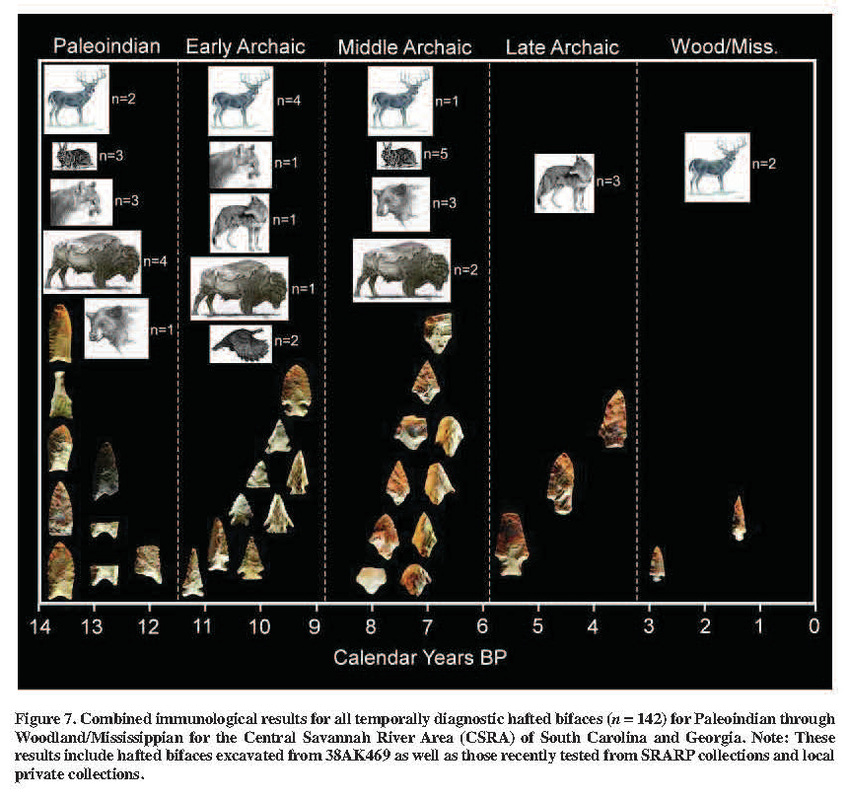What if all of those dioramas and illustrations of Paleoindian peoples swarming a mastodon mired in the muck are complete baloney?
What if one of our most popular baseline notions about Clovis in the east is totally wrong?
Here is a summary figure from the published paper:
As explained in the American Antiquity paper, the positive evidence for bison populations in the region in the Late Pleistocene is consistent with several other data points (including previous protein residue studies and radiocarbon-dated remains such as the Wacissa bison). The new residue data also support the continued presence of bison in the region into the mid-Holocene. That's pretty interesting to me, as it suggests that the exploitation of a large game animal that is more-or-less invisible in the faunal records (both archaeological and natural) may have been important to the food economies of the Archaic peoples I'm keenly interested in understanding.
And what about the absence of hits for proboscidean? That's pretty interesting as well. Near the end of his ASSC presentation, Moore informally posed a great "what if" question (and I'm paraphrasing here): what if the evidence for human involvement with mammoths/mastodons in eastern North America actually pertains to pre-Clovis rather than Clovis peoples?
For me, pondering that question was one of those nice "wait a @#!%*$# second . . ." moments that happens every so often in science. What if we have not just exaggerated the embrace between Clovis and megafauna in the east, but allowed our romantic notions (and the very clear evidence of Clovis-age megafaunal predation in the west) to blind us to the real pattern that's present?
Impossible, you say? Let's ask a series of questions. I'll give you the answers based on what I know off the top of my head and what I have time to assemble on Monday morning of a busy week. Please correct me if I'm wrong on something or help me add things I've left out -- I'm not making any claim that this listing of evidence is exhaustive. Note: when I say "eastern North America" I mean east of the Mississippi River.
Question: Are there any direct associations between Clovis stone tools and mammoth/mastodon remains in eastern North America?
Answer: No. As far as I know, Kimmswick (Missouri) is the farthest east Clovis-associated megafaunal kill site.
Question: Are there any human-butchered mastodon/mammoth remains in eastern North America that have been dated to the Clovis period (i.e., 11,050-10,800 radiocarbon years before present [RCYBP]; ~13,250-12,800 Calendar years before present; ~11,300-10,850 BC)?
Answer: Not that I know of off the top of my head. The eastern cases of purported mastodon/mammoth butchery of which I am aware pre-date the known age range of Clovis. Here are some examples:
- Hebior mammoth (Wisconsin): ~12,500 RCYBP;
- Burning Tree mastodon (Ohio): ~11,500 RCYBP (Fisher et al. 1994);
- Aucilla River mastodon tusk (Florida): ~12,200 RCYBP;
Question: Is there any direct evidence that mammoths/mastodons survived into Clovis times in eastern North America?
Answer: Yes. There are directly-dated mammoth and mastodon remains that demonstrate that proboscideans survived into and beyond Clovis times. The period 10,500-10,000 RCYBP (i.e., post Clovis) is probably a reasonable extinction window for mastodons in the east. Here, for example, is a report of a mastodon from northern Indiana dated to about 10,000 RCYBP.
Question: Is there any direct evidence that Clovis peoples used parts of mammoths/mastodons obtained from recently deceased animals?
Answer: Yes, apparently. There are ivory and bone tools from Florida that are attributed to Clovis. Here is a quote from a paper by Bruce Bradley:
It seems pretty clear that Clovis peoples existed on the landscape (or were at least present in eastern North America at the same time) as proboscideans. They apparently used parts of those animals to fashion tools. But the case for active Clovis-age predation of mammoths and mastodons continues to be based on circumstantial evidence. As more and more purported proboscidean butchery sites of pre-Clovis age are reported from the Eastern Woodlands, it seems less likely that the east-west contrast in megafaunal kill sites is solely the result of a preservation bias: it's not the elephants that are missing, but the direct evidence that Clovis peoples hunted them.
If we take mammoths and mastodons out of the Clovis picture, there's a lot of explaining to do. What was the point of all that beautiful technology? I was one of several junior co-authors on a paper (Speth et al. 2013) that attempted a political re-imagining of Early Paleoindian fluted point technologies. While I'm not convinced by all the arguments in that paper, I think it was a useful exercise. There are other alternatives to the dominant "Clovis meat machine" model that can be constructed.
And what if bison was an important game animal in some portions of the Eastern Woodlands into the Middle Archaic? What if bone preservation issues really are part of the problem for our interpretations of the Early and Middle Holocene and we've been unable to see (and therefore to factor into our models) a large herbivore that may have been a huge part of the subsistence economies of early hunting-gathering societies in the region? That deserves a very hard look.
I've used all the time I can spare to write about this today. I'm hoping some of you find this question interesting and point out things I'm not aware of. I'll be returning to this as I have time - it's a pretty cool set of questions to think about.




 RSS Feed
RSS Feed
